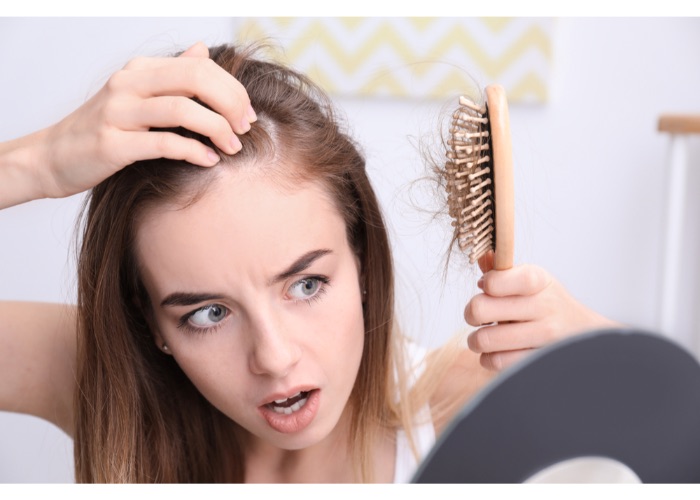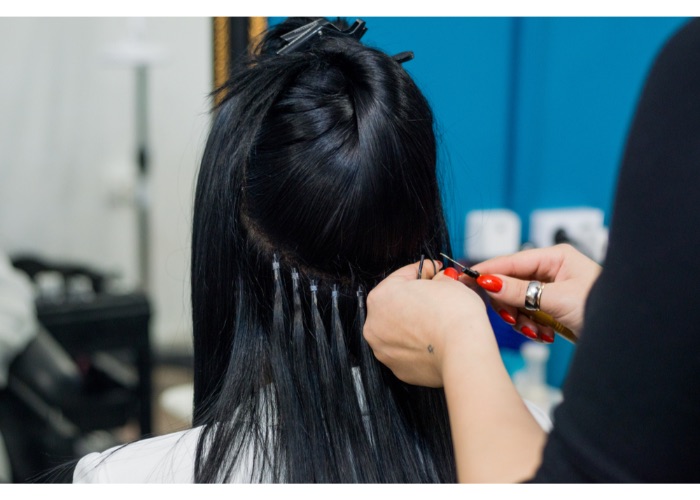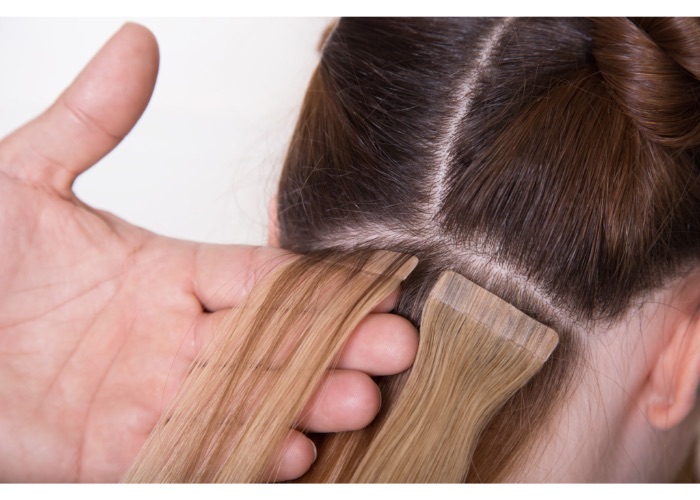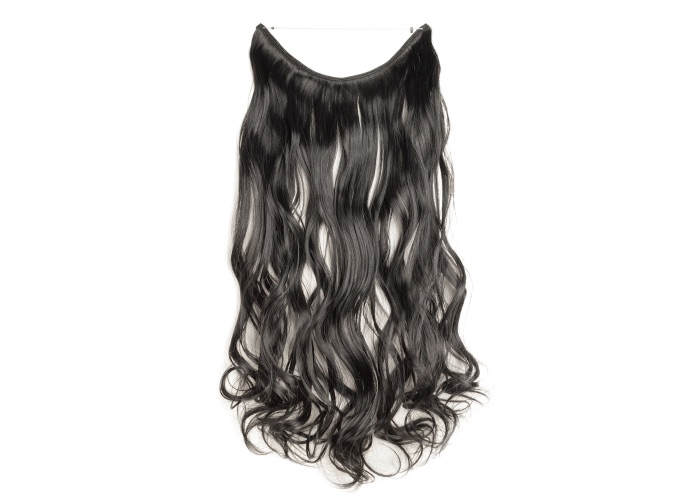Hair Extensions for Fine Hair: Which Types are the Least Damaging?
Picture a model with long, silky smooth hair walking towards the camera. Her hair is beautifully styled and flawless. We’ve all probably dreamed of achieving such luscious, camera-ready hair. After all, hair and beauty advertisements flood us with gorgeous imagery on a daily basis. Achieving and protecting the hair of your dreams isn’t always easy and requires lots of dedication.
Luckily, hair extensions can help you achieve most of your hair goals. Extending the natural length of your hair has never been easier thanks to talented hairstylists and modern hair extension installation techniques. Hair extensions can work wonders on virtually any hair length, thickness, and texture. However, it’s important to exercise caution if you have thin or fine hair, as some hair extensions might not be suitable for you. The wrong type of extensions for your hair type could do more harm than good. Always book a consultation with an experienced stylist before committing to hair extensions. So, which types of hair extensions are the best and least damaging for fine hair?
Can you put extensions in very thin hair?

For people with naturally thin hair, the temptation to have a head full of mesmerizing hair proved too intriguing to let go. People started trying various methods to ease the pain and stretch the usability of the extensions while trying to suffer less from the side effects. At the time, the extensions had a reputation for damaging the hair, and anyone sporting fine hair had to simply accept the trade-off.
But as hair extensions became more mainstream and the companies and innovators of the beauty industry invented newer models and methods, some hair extensions proved to be less damaging for fine hair. It was understood that attaching fewer hair extensions would seem more successful on thinner hair. Also, the methods that needed less force to be applied were proven to provide a better experience that lasted longer. The hair types which were already fragile seemed to have a lower breakage rate when dealing with extensions that caused less additional stress to the hair shafts.
So in the quest for finding the least damaging hair extensions for thin hair, there seemed to be hope for success. But a few questions begged to be answered: What was causing all the discomfort to the people with fine hair? What was the reason behind all the side effects?
Do extensions damage fine hair?

Beauty professionals were curious why the extensions work better on some hair types and worse on others. On the topic of extensions, the main differing factor was the amount of weight that each hair type could endure. It was deduced that the difference in the outcome was simply that the thicker hair could carry heavier loads of hair, just like ropes with more girth. Like other areas in the human body, naturally, hair strands are only strong enough to carry their own weight, so anything above that would feel heavy. Now, if you have bigger muscles, lifting heavier things than just your body parts seems easy. But if your muscles are more petite, every object would appear as a heavy burden. Adding extensions to thinner hair is exactly like that. Ultimately, It was proven that a highly influential factor for hair loss was the weight of the hair extensions. So the beauticians tried lighter hair extensions on more sensitive hair to reduce the load. Everything was supposed to be fixed, right?
There was a noticeable improvement, and lighter extensions were definitely less damaging for fine hair. However, the damage was still inevitable. The hair loss, headaches, and occasional allergic reactions still prevented the clients from wearing hair extensions. To further experiment with solutions to decrease the damage, hairdressers found out the weight of the extensions wasn’t the only harmful element of them. Still, another effective factor to the damage was found to be the strains of all the heat, sewing, and adhesives applied in the process. Again, just like ropes, thinner hair has fewer molecules to keep itself safe from the force of all the tensions that happen in the applications of traditional and hair extension methods and is prone to breakage and falling.
These findings on the search for the least damaging hair extensions for fine hair led to better available choices for people who were after adding length and density to their hair but suffered from all the side effects of improper methods.
In this article, we introduce more delicate approaches for hair extension application and help you protect your precious fine hair while wearing extensions. We bring you 3 of the most popular methods that worked better on the clients who were on the thinner side of the table:
Hand-Tied Hair Extensions

Think of hand-tied extensions as an intermediary between your natural hair and the added volume. They work by using tiny beads made of silicon, which are added to strands of natural hair, acting as leverage that would lift the weight of the extensions instead of putting all the load on the hair shaft. The extensions are made to rows of strands like curtains and are tied to the beads and then covered by real hair, resulting in a smooth, natural, and much less damaging blend.
Hand-tied hair extensions release your hair from all the tensions that would otherwise be caused by conventional methods such as clips ins and sew-ins because they are not directly in contact with your hair shafts and use no chemical adhesive. They also look much more natural because the curtains of hair extensions are very flexible and flat and are attached closer to your scalp, residing secretly next to your hair roots without making a clump. They are great solutions for adding volume and length to thin hair and work well with wavy or straight hair as they both lay closer to the scalp and can be tied more easily.
Also Read: What’s The Difference Between Weaves And Hair Extensions?
Tape-In Hair Extensions

These hair extension types have been around for some time, and despite using some kind of adhesive, they still prove to be one of the least damaging hair extensions for fine hair. That’s because their type of glue is not one of those liquid and very sticky types that are poured on the scalp or over the hair, but they are of the polyurethane tapes that are used everywhere in medical-grade situations. When using Tape-Ins, each weft of hair is very lightweight, and no amount of heat or chemicals is endured by your hair shafts.
Applying tape-in hair extensions is has a pretty straightforward yet sensitive procedure, so it is highly recommended for the clients to ask professionals to do so. Basically, using the tape-in method, two rows of extensions are placed above and beneath a row of natural hair. They are secured together with the mentioned bonding, making a sandwich of extensions and hair. With thinner hair, you could skip wrapping the tape around the hair and just use one side of the tape to hold everything together to make it extra light and flat. There is also the option to tape one weft of extension instead of the usual two, achieving less weight on the head. Again, just like hand-tied extensions, the result will be very flat and will be easily hidden behind your natural hair.
Tape-in extensions can last long if applied and taken care of properly. Taking roughly about 30 to 90 minutes, they are easy to apply and remove and can be held securely together for approximately 6 weeks. By renewing the tapes, you can increase their lifetime up to another 8 weeks as well.
Once distributed evenly across the head and almost no stress tolerated by each hair strand, Tape-ins are one of the least damaging hair extensions for fine hair and have been used widely by users with more sensitive hair.
Halo Hair Extensions

Halo hair extensions have no bonding with your natural hair whatsoever, unlike almost all the other hair types. They use no external objects to hold them on your head, need no adhesives or tapes, and do not even need to be tied or sewn. They simply will be worn, worthy of the angel that you are, like a halo of beautiful silky hair.
The hair strands are held together with a transparent wire that sits on your head like a headband. The trick is that the hair lies underneath your actual hair, so the weight of your hair is what secures the extension on your head. The length of the round wire is fully customizable and can be adjusted to perfection so that it doesn’t move quickly and it isn’t very tight either.
Halo hair extensions are arguably the fastest hair extensions to apply and remove every concern we mentioned from the conversation. The connectionless method will not pull the hair follicles from your hair. The lack of objects, ties, and tapes is why halo extensions are exceptionally comfortable to wear. Removed in a matter of seconds, they are perfect for one-night applications and will not tamper with your showers and sleep.
The only downsides would be limitations in styling, as they are not very suitable for up-dos or top-knots and are mainly used to be laid down on your shoulders or used with lower styles. They are also not the best choice for people with shorter hair because of the difficulties with hiding the wire.
As far as the least damaging hair extensions for fine hair, Halo hair extensions check all the boxes in terms of safety and are the ultimate choice for people who sport fine and thin hair and want to extend their natural beauties using external hair additions.
How many hair extensions do I need for thin hair?
The number of added hair extensions depends heavily on your current hair density and length and your future desired outcome. This is because of all the precautions you have to consider concerning your hair type and the details you have to review when choosing a hair extension to get you closer to the look you are after.

Determining your hair density is not the hardest thing to do. You need to consider that the hair density combines hair number and hair thickness, meaning that someone with thick hair but not a lot of it falls in the category of low density and vice versa. If you are looking for hair extensions, the chances are that you want that dense, sleek, and long-haired look, and hair density states how many heir extensions do you need to achieve that.
A quick way to determine hair density is to see how long it takes to dry your hair with a blow dryer. If it takes 1 – 2 minutes to blast dry your hair, then you fall on the thinner side. If it takes you 3 – 4 minutes, you lean towards the average, and anything beyond that can be called a thick or fuller head of hair and can carry as many hair extensions as possible to reach ambitious hair goals.
The other crucial element is your current hair length. If your hair is fine and is very short, you will probably need about a full head of hair extensions to add length but not much more as it cannot take much more weight. If your fine hair is as long as your chin or your shoulder, then around 75 to 100 hair extensions can do the trick of adding volume, and up to 150 can be used to lengthen your hair. If you have thin hair that is longer than your shoulder, about 100 hair extensions can be sufficient to give you a voluminous look.